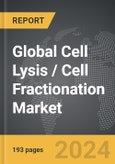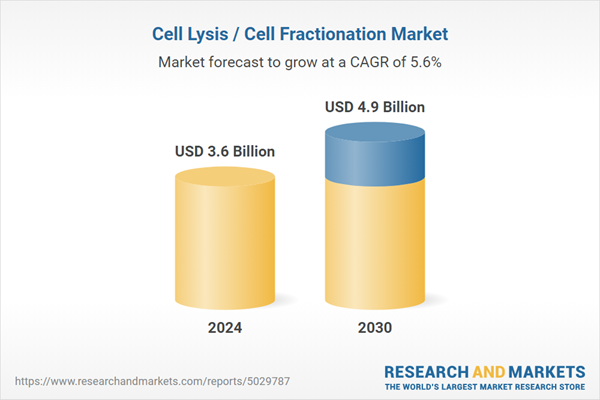The global market for Cell Lysis / Cell Fractionation was valued at US$3.6 Billion in 2024 and is projected to reach US$4.9 Billion by 2030, growing at a CAGR of 5.6% from 2024 to 2030. This comprehensive report provides an in-depth analysis of market trends, drivers, and forecasts, helping you make informed business decisions.
Global Cell Lysis / Cell Fractionation Market - Key Trends and Drivers Summarized
How Is Cell Lysis Essential to Unlocking Biological Research?
Cell lysis is a foundational technique in biological research, essential for breaking open cells to release their internal contents, such as proteins, DNA, RNA, and organelles. This process is a critical first step in many experimental workflows, including genomics, proteomics, and metabolomics, where the analysis of cellular components is required to understand biological processes, disease mechanisms, and therapeutic targets. Cell lysis can be achieved through mechanical, chemical, or enzymatic methods, depending on the type of cells being lysed and the downstream application. Mechanical methods, such as sonication or homogenization, are often used to disrupt tougher cell types like bacterial or plant cells, while enzymatic approaches, like lysozyme treatment, are common for more delicate samples, ensuring the preservation of sensitive biomolecules. The success of cell lysis directly impacts the quality of the resulting cellular fractions, which makes choosing the appropriate method crucial. Over the years, innovations in lysis techniques have improved the yield and purity of cellular contents, which is particularly important in high-precision applications like protein purification and nucleic acid extraction for sequencing. Cell lysis, therefore, remains a vital tool in both research and industrial bioproduction, allowing scientists to dissect and understand the inner workings of life at a molecular level.Why Is Cell Fractionation Crucial for Studying Subcellular Structures?
Cell fractionation, the process of separating cellular components after lysis, is indispensable for studying the function and structure of individual organelles and macromolecules. Once the cells have been lysed, fractionation techniques, such as centrifugation, are used to separate the various subcellular components like the nucleus, mitochondria, endoplasmic reticulum, and cytoplasm. This is particularly important in understanding cellular processes such as energy production, protein synthesis, and apoptosis, where the roles of specific organelles must be examined in isolation. Advances in ultracentrifugation and density gradient fractionation have enabled more precise isolation of these components, allowing researchers to study their biochemical properties and interactions in great detail. In fields like neurobiology and cancer research, where the behavior of cellular organelles can significantly influence disease progression and treatment responses, cell fractionation is essential. Moreover, cell fractionation has wide applications in the development of pharmaceuticals, as isolating organelles allows scientists to better understand drug mechanisms and metabolic pathways, ultimately guiding the development of more targeted therapies. As the need for subcellular analysis grows, cell fractionation continues to evolve, supporting the detailed exploration of cellular components in various biomedical fields.How Are Technological Innovations Shaping Cell Lysis and Fractionation?
Technological innovations have dramatically transformed the landscape of cell lysis and fractionation, making these processes more efficient, scalable, and precise. One of the most notable advancements is the development of automated systems that allow for high-throughput cell lysis, streamlining workflows in large-scale studies such as drug discovery and genomic research. These automated systems minimize human error and reduce variability, which is crucial when working with sensitive samples or when consistency is required across multiple experiments. Additionally, novel non-mechanical lysis techniques, such as electroporation and pressure cycling technology, have emerged, offering gentler alternatives to traditional methods and reducing the risk of protein denaturation or damage to fragile cellular components. These innovations are particularly valuable in proteomics, where maintaining the integrity of proteins is critical for downstream analysis. On the fractionation front, advancements in microfluidics have enabled more precise separation of cellular components at the microscale, reducing sample loss and improving the purity of the fractions. This has opened new doors for single-cell analysis, where tiny amounts of cellular material must be handled with extreme care. Moreover, the integration of machine learning algorithms into fractionation processes is enhancing the ability to predict and optimize fractionation outcomes based on specific cellular characteristics. These technological developments are driving the field forward, ensuring that cell lysis and fractionation remain at the cutting edge of molecular biology research.What Is Driving Growth in the Cell Lysis and Fractionation Market?
The growth in the cell lysis and fractionation market is driven by several factors, including advancements in biotechnology, rising demand for personalized medicine, and the expanding scope of proteomics and genomics research. As the biopharmaceutical industry continues to develop targeted therapies, particularly for cancer and neurodegenerative diseases, the need for high-precision cell lysis and fractionation tools has grown exponentially. Technological advancements, such as automated and high-throughput lysis systems, are making it easier for researchers to process large numbers of samples quickly and efficiently, which is critical in fields like drug discovery and clinical diagnostics. The increasing focus on single-cell analysis, where researchers need to isolate and analyze the contents of individual cells, is also driving demand for more sophisticated lysis and fractionation technologies. Additionally, the rise of proteomics in understanding complex biological systems is fueling the need for advanced fractionation techniques that can isolate and preserve protein complexes with high fidelity. Consumer behavior is also playing a role, as patients and healthcare providers push for more personalized and precise treatment options, which depend on the detailed cellular and molecular data that these technologies provide. Furthermore, regulatory requirements for biologics production and quality control in the pharmaceutical industry are encouraging the adoption of robust cell lysis and fractionation solutions to ensure that drug manufacturing processes meet stringent standards. These factors, coupled with increased investment in life sciences research, are expected to continue driving the growth of the cell lysis and fractionation market in the coming years.Report Scope
The report analyzes the Cell Lysis / Cell Fractionation market, presented in terms of market value (US$ Thousand). The analysis covers the key segments and geographic regions outlined below.Segments
Component (Consumables, Instruments); Type (Mammalian Cells, Microbial Cells, Other Types); End-Use (Research Laboratories & Institutes, Pharma & Biotech Companies, Other End-Uses).Geographic Regions/Countries
World; United States; Canada; Japan; China; Europe (France; Germany; Italy; United Kingdom; and Rest of Europe); Asia-Pacific; Rest of World.Key Insights:
- Market Growth: Understand the significant growth trajectory of the Cell Lysis / Cell Fractionation Consumables segment, which is expected to reach US$3.1 Billion by 2030 with a CAGR of a 6.7%. The Cell Lysis / Cell Fractionation Instruments segment is also set to grow at 4.0% CAGR over the analysis period.
- Regional Analysis: Gain insights into the U.S. market, valued at $958.4 Million in 2024, and China, forecasted to grow at an impressive 5.3% CAGR to reach $774.8 Million by 2030. Discover growth trends in other key regions, including Japan, Canada, Germany, and the Asia-Pacific.
Report Features:
- Comprehensive Market Data: Independent analysis of annual sales and market forecasts in US$ Million from 2024 to 2030.
- In-Depth Regional Analysis: Detailed insights into key markets, including the U.S., China, Japan, Canada, Europe, Asia-Pacific, Latin America, Middle East, and Africa.
- Company Profiles: Coverage of major players such as Beckman Coulter, Inc., Becton, Dickinson and Company, Bio-Rad Laboratories, Inc., Cell Signaling Technology, Inc., Merck KgaA and more.
- Complimentary Updates: Receive free report updates for one year to keep you informed of the latest market developments.
Why You Should Buy This Report:
- Detailed Market Analysis: Access a thorough analysis of the Global Cell Lysis / Cell Fractionation Market, covering all major geographic regions and market segments.
- Competitive Insights: Get an overview of the competitive landscape, including the market presence of major players across different geographies.
- Future Trends and Drivers: Understand the key trends and drivers shaping the future of the Global Cell Lysis / Cell Fractionation Market.
- Actionable Insights: Benefit from actionable insights that can help you identify new revenue opportunities and make strategic business decisions.
Key Questions Answered:
- How is the Global Cell Lysis / Cell Fractionation Market expected to evolve by 2030?
- What are the main drivers and restraints affecting the market?
- Which market segments will grow the most over the forecast period?
- How will market shares for different regions and segments change by 2030?
- Who are the leading players in the market, and what are their prospects?
Some of the 44 major companies featured in this Cell Lysis / Cell Fractionation market report include:
- Beckman Coulter, Inc.
- Becton, Dickinson and Company
- Bio-Rad Laboratories, Inc.
- Cell Signaling Technology, Inc.
- Merck KgaA
- Miltenyi Biotec GmbH
- Qiagen NV
- Qsonica L.L.C.
- Roche Diagnostics
- Thermo Fisher Scientific, Inc.
Table of Contents
I. METHODOLOGYII. EXECUTIVE SUMMARY2. FOCUS ON SELECT PLAYERSIII. MARKET ANALYSISIV. COMPETITION
1. MARKET OVERVIEW
3. MARKET TRENDS & DRIVERS
4. GLOBAL MARKET PERSPECTIVE
UNITED STATES
CANADA
JAPAN
CHINA
EUROPE
FRANCE
GERMANY
ITALY
UNITED KINGDOM
REST OF EUROPE
ASIA-PACIFIC
REST OF WORLD
Companies Mentioned (Partial List)
A selection of companies mentioned in this report includes, but is not limited to:
- Beckman Coulter, Inc.
- Becton, Dickinson and Company
- Bio-Rad Laboratories, Inc.
- Cell Signaling Technology, Inc.
- Merck KgaA
- Miltenyi Biotec GmbH
- Qiagen NV
- Qsonica L.L.C.
- Roche Diagnostics
- Thermo Fisher Scientific, Inc.
Table Information
| Report Attribute | Details |
|---|---|
| No. of Pages | 193 |
| Published | April 2025 |
| Forecast Period | 2024 - 2030 |
| Estimated Market Value ( USD | $ 3.6 Billion |
| Forecasted Market Value ( USD | $ 4.9 Billion |
| Compound Annual Growth Rate | 5.6% |
| Regions Covered | Global |









